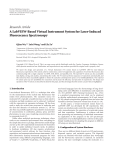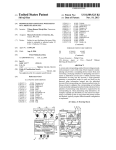Download The Parallel C Preprocessor* - Hindawi Publishing Corporation
Transcript
The Parallel C Preprocessor*
EUGENE D. BROOKS III, BRENT C. GORDA, AND KAREN H. WARREN
Massively Parallel Computing Initiative, Lawrence Livermore National Laboratory, Livermore, CA 94550
ABSTRACT
We describe a parallel extension of the C programming language designed for multiprocessors that provide a facility for sharing memory between processors. The programming model was initially developed on conventional shared memory machines
with small processor counts such as the Sequent Balance and Alliant FX/8, but has more
recently been used on a scalable massively parallel machine, the BBN TC2000. The
programming model is split-ioin rather than fork-ioin. Concurrency is exploited to use a
fixed number of processors more efficiently rather than to exploit more processors as in
the fork-join model. Team splitting, a mechanism to split the team of processors executing a code into subteams to handle parallel subtasks, is used to provide an efficient
mechanism to exploit nested concurrency. We have found the split-join programming
model to have an inherent implementation advantage, compared to the fork-join model,
when the number of processors in a machine becomes large.© 1992 by John Wiley & Sons, Inc.
1 INTRODUCTION
Shared memory multiprocessors, wherein a small
number of processors access a common monolithic system memory, have been around for a long
time. The frequently used parallel programming
model on these systems is the fork-join model,
where one processor starts out executing the serial
code and additional processors are acquired when
a parallel construct is encountered. Although the
fork-join model is serving well in the form of vendor supplied implementations on machines with a
small number of processors such as the Cray YMP
and the Convex C-2 series, fundamental shortcomings in its implementation begin to surface
* Work performed under the auspices of the U.S. Department of Energy by the Lawrence Livermore :'1/ational Laboratory under contract No. W-7405-ENG-48.
Received February 1992.
Revised April 1992.
© 1992 by John Wiley & Sons, Inc.
Scientific Programming, Vol. 1, pp. 79-89 (1992)
CCC 1058-9244/92/010079-11$04.00
when the number of processors grows. These
shortcomings have become apparent through our
experiences with the vendor supplied fork-join extension of Fortran [1] supplied by BBN on their
TC2000 multiprocessor.
It is no longer possible to build a monolithic
shared memory system that can sustain the bandwidth and latency demands of hundreds or thousands of processors when the number of processors is scaled up. Large local memories are
introduced in order to provide an acceptable level
of memory performance in such systems. Use of
the shared memory facility in large parallel systems is best relegated to those times when communication is absolutely required by the application, as the bandwidth and latency of the shared
memory are likely to be an order of magnitude
short of the performance required to keep a processor running at full speed. The problem with the
fork-join model is that the process of acquiring
and relinquishing processors requires highly contended accesses for the shared memory, or some
specialized hardware mechanism to handle processor dispatch. Although the fork-join program-
79
80
BROOKS, GORDA, AND WARREN
ming style is comfortable, the high overhead of its
implementation quickly becomes burdensome.
An alternative to the fork-join model is the
split-join programming model. In the split-join
paradigm, all the processors that the code will ever
have will enter the main program in a live manner
at the start of the job. Processors are not fetched
from and returned to a pool. This involves accesses to shared memory to implement. PCP [2] is
an implementation of the split-join programming
model that provides a good fit to massively parallel
machines offering a shared memory facility in addition to the local memory that such machines
usually have. Its constructs, though simple, provide powerful and efficient flow control in the form
of parallel loops and team splitting. The programming model is a relatively straightforward extension of the conventional C programming model.
An arbitrary number of processors executes the
code stream as a single processor executes a serial
program.
Nested concurrency is exploited through the
structured mechanism of team splitting, in which
the team of processors divides up into sub teams in
order to address independent but parallel tasks at
a lower level. These subteams are relatively independent of one another, and are free to execute
different code modules, until they rejoin the parent team in a block structured manner.
The PCP programming language places the issues of scheduling, communication, and synchronization directly into the hands of the programmer. It does this in a simple manner by providing
useful constructs to handle these complexities.
PCP allows the user to specify which portions of
the program are to be executed in parallel, which
are to be executed by subteams, and which are to
be executed by one processor only. PCP allows
any number of processors to be allocated to a job,
the number of processors being a run time parameter that is set by the end user of the code when
the program is actually executed. Through the use
of a compile time flag, the PCP preprocessor can
also produce serial code that does not contain the
run time synchronization overhead required for
parallel execution. This feature is often used to
provide both a sanity check and a point of performance comparison for parallel executions.
The split-join parallel programming paradigm
is independent of the target language. Examining
the basic programming model, it is quickly concluded that any procedural programming language could be extended with a split-join programming model. This is indeed the case and on
the BBN TC2000 we have developed a Fortran
implementation, the Parallel Fortran Preprocessor (PFP). We discuss only the C syntax for the
split-join programming model for the sake of brevity (see Warren et al. [3] if you are interested in the
Fortran syntax).
PCP was originally written to solve the problem
of the portability of C language based parallel programs among several different shared memory
multiprocessors. The PCP preprocessor is machine independent; the amount of machine dependent run time support is small (200 lines of C
on the BBN TC2000) and can be easily implemented with fast inline code. PCP has been used
successfully on the Alliant, Sequent, Cray, SCI,
and Stellar machines.
The sections of this paper are as follows. The
split-join model and its memory model are described in Sections 2 and 3. Details on how the
implementation of these models take advantage of
the architecture are included. The PCP team state
is discussed in Section 4. The synchronization
primitives offered in PCP are discussed in Section
5. The actual PCP syntax is shown in Section 6. In
Section 7 we discuss the issues of implementing
and using PCP on a scalable machine such as the
BBN TC2000. A general discussion follows in
Section 8.
2 THE SPLIT -JOIN MODEL
In the traditional fork-join parallel programming
model, a single processor starts the execution of
the program and acquires more processors as
concurrency is encountered in the code. The forkjoin programming model has been quite useful on
tightly coupled shared memory machines with relatively few processors. Some architectures such as
the Alliant FX/ 8 and the Convex C2 provide special hardware to make the dispatch of slave processors happen as quickly as possible. Scalable
machine architectures are not as tightly coupled
and the cost of communication between processors, heavily used in process of dispatching processors in the fork-join model, is relatively high.
The BBN TC2000, described in more detail in
Section 7, is a realistic example of what might be
expected in this regard. The latency of a cache hit
on local memory is 3 clocks (pipelined at a rate of
one per clock) whereas the latency of a remote
memory reference is roughly 40 clocks (not pipelined). If one must deal with a 40 clock latency for
every memory reference required in the code used
PARALLEL C PREPROCESSOR
to dispatch processors, even an efficient spanning
tree implementation can have substantial overhead.
In the split-join paradigm we deal with the high
cost of processor dispatch and communication
between processors by minimizing their occurrence in the fundamental constructs of the programming model. All of the processors the job will
ever acquire are dispatched at the start of the program and are immediately placed under the control of the programmer. This group of processors,
which loosely follow each other through the code,
is referred to as a team of processors. In a serial
program a single processor enters the main( )
routine and executes code until it either retums
from main( ) , calls exit( ) , or encounters an exception. In the PCP model we generalize this in a
natural way, having a team of processors enter
main() and having the job end when any team
member returns from main(), calls exit( ), or encounters an exception. A team of processors consists of a team master and zero or more other processors, which travel through the code almost in
unison.
The split-join parallel programming model is
very similar to Harry Jordan's Force [4] and the
IBM SPMD [5] programming model, the most significant difference being the support for team
splitting and the arbitrary nesting of concurrency
constructs. The PCP concept of team splitting allows an arbitrary subdivision of the team of processors executing the code and allows each subteam to execute arbitrarily different codes within
the constraint of block structure. This is a flexible
extension of the SPMD programming model that
supports the exploitation of nested concurrency
for both subroutines and nested loops.
The PCP concept of teams is dynamic and well
suited for massively parallel machines. The user
synchronizes the members of a team, designates
tasks for individual team members, and splits up
the team into smaller sized teams to execute logically distinct code sections. All parallel constructs
apply to teams. Working within any team the programmer has access to the parallel looping constructs, the barrier, locks, and even further team
splitting. In the team splitting process the total
number of processors remains constant. The processors temporarily become members of new subteams. As this happens, the processors save their
old state for restoration at the end of the split construct. As processors within a team complete their
work, they then rejoin the parent team with no
implicit serialization.
81
Team splitting is used to exploit nested concurrency with a fixed number of processors. In the
split construct the user explicitly marks off separate blocks of work that can be executed independently (each block of work may itself be a job consisting of subtasks that can be executed in
parallel). The user may also indicate the relative
amount of work in each block of code. The PCP
split construct takes an optional weight parameter
that controls the fraction of processors to send
into each team. This form of load balance control
is effective if the workload can be accurately predicted at execution time, as is the case for the two
concurrent linear system solves below. The team
splitting weights, which occur in an iterative loop
during execution, might also be corrected by using
a real time clock to detect imbalance in a prior
iteration and adjusting the weights of the next iteration appropriately. This second strategy would
be effective if the relative load of two split tasks
varied slowly with the iteration index.
Splitting the team into smaller subteams to exploit nested concurrency is counter intuitive. The
goal, however, in executing nested concurrency is
to use a fixed number of processors more efficiently, not to use more processors. The split-join
programming model is in some sense the dual of
the fork-join model. One finds that one can usually accomplish the task at hand with either programming model. The advantage of the split-join
model is its bottleneck free implementation
through a highly portable preprocessor. As will be
seen in Section 4, the process of team splitting is
accomplished in a few instructions, independent
of the size of the team, which only access local
memory.
Teams may be split both statically and dynamically. Static team splitting is specified using the
keywords split and and. As an example, consider
the routines foo() and bar(), which perform an
equal amount of work and can be called concurrently. In the PCP model the concurrent execution
of the two routines is arranged through the syntax:
split
{
foo();
}
and
{
bar( );
}
where the amount of work performed by foo()
82
BROOKS, GORDA, AND WAHREN
and bar( ) is assumed to take the same amount of
time. The team encountering the split divides into
two subteams of equal size. The first subteam
calls foo( ) while the second calls bar( ) concurrently, and the two subteams join again at the end
of the and block. The tasks performed in foo( )
and bar( ) must be independent. If there is only
one processor in the team that encounters the
split, or if an implementation limit for team splitting has been reached, the encountering team
calls foo( ) and then bar( ) sequentially in an implementation dependent order. For this reason,
one must view the execution of foo( ) and bar( )
to be completely asynchronous. The algorithms
implemented by foo() and bar( ) should not be
designed in a way that requires simultaneous progress in both routines. This could be done, but the
code would not be portable to multiprocessors for
which the team size entering the split block is
unity.
In addition to the static splitting described
above wherein the amount of work performed in
each block of code is assumed to be the same,
weights may be assigned to the blocks of work. If
the user has provided accurate loading information, via the weight parameters for team splitting
(see Section 6.5) that determine the subteam
sizes, the processors in the subteams finish their
work and rejoin to become the parent team nearly
simultaneously. The total number of processors is
conserved in the team splitting process. As an example of team splitting with weights, consider the
case of two concurrent linear system solves that
are for potentially differing dimensions. (For a description of the Gauss elimination implementation
in this model see Warren et al. [6])
int dim1, dim2;
double **matrix1, **matrix2;
double *rhs1, *rhs2;
split dim1 *dim1 *dim1 {
dgauss(matrix1, rhs1, dim1);
}
and dim2*dim2*dim2 {
dgauss(matrix2, rhs2, dim2);
}
Here the routine dgauss( ) performs a linear
system solve leaving the result in the vector rhs
provided as an argument. The operations required scale like the cube of the dimension and
this is noted by the weight expressions included on
the split and and lines. The weight expressions
are used to compute the sizes of the two subteams,
dividing the parent team into two sub teams having
relative sizes that match the ratio of weights as
closely as possible. By specifying weights for the
concurrent blocks of work some measure of load
balancing can be achieved, subject to the algebraic restrictions caused by the fact that the number of processors is finite.
Split constructs are not limited to the static binary form shown above. Static splits may have
more parallel blocks specified by concatenating
and blocks.
Team splitting may also be treated dynamically. The construct:
splitall(int i = 0; i < imax; i += 1)
{
<work dependent on the index, i>;
}
specifies that the body of the loop is to be executed with the indices i
0, 1, . . . , imax- 1,
parceling out the indices to a collection of subteams that are split off from the team that encounters the split. The actual number of subteams is
determined at run time, and is possibly influenced
by a compile time flag. There may not be a split at
all or the team may be split to individual processors, using the best heuristic algorithm that can be
conjured up. Extra parameters (see Section 6.6)
inside the splitall header can be used to establish
firmer control of the team splitting mechanism.
To give a trivial application of the splitallloop,
consider the parallel computation of a set of matrix vector products.
=
double **result;
double ***matrices;
double **multplcnd;
int dim;
int number;
splitall(int i = 0; i < number; i += 1) {
mvprod(result[i], matrices [i],
multplcnd[i], dim);
}
If a team split would be profitable, the team
encountering the splitall block is divided into
subteams, each subteam handling a subset of the
indices i. The library routine mvprod( ) is designed for team entry and contains parallel language constructs designed to efficiently exploit the
parallelism of each matrix vector product. If the
team that enters the splitallloop has 100 processors and the number and dimension of the matrix-
PARALLEL C PREPROCESSOR
vector products is 5 and 20, respectively, we see
that the use of team splitting will have a substantial impact on program performance.
3 THE MEMORY MODEL
PCP allows the user to designate the memory class
for all data. In the split-join programming paradigm itself, three types of memory are provided to
fully exploit the notion of team splitting. These
are:
1. Memory that is private to a processor, private memory
2. Memory that is shared among all processors, shared memory
3. Memory that is shared among the members of a given team or grouping of processors, but private to the team, teamprivate
memory
Private memory is implemented on the processor that requires access to it. Shared memory is
implemented in the interleaved shared memory
facility (see Section 7) of the BBN TC2000. There
are many situations where a user would like to
have static data that is not shared by all processors, but is shared by all of the processors within a
given team. This type of data is declared using the
storage class modifier teamprivate. Teamprivate
memory is allocated as an array in the interleaved
shared memory, indexed by a team descriptor that
is unique to a given team. More details on the
team descriptor are given in Section 4.
By default, all statically allocated data is shared
and thus accessible by all of the processors. Stack,
or auto, data is private to a processor and is
stored in a processor's local memory if it exists.
The choice of default for statically allocated data
is a holdover from the days of running PCP codes
on shared memory machines such as those manufactured by Sequent or Alliant, and is not that
appropriate for a scalable machine such as the
BBN TC2000. Fortunately, the default can be
switched to private through the use of a compile
time flag.
4 TEAM STATE
The PCP concept of teams is implemented using a
small amount of local memory. The team state,
which is carried by the processors, is made avail-
83
able to the programmer who may use it to construct parallel language extensions that are not directly supported. The current features of PCP
were not postulated before its first implementation. These features evolved over time as users
constructed some of their own using the team state
variables. Those features that were found to be
generally useful have been standardized and elevated to constructs directly supported by the Parallel C Preprocessor itself. Further evolution of the
parallel programming model in this manner will
reduce the need to directly use the team state, but
the team state will always remain accessible to the
programmer both for backward compatibility and
to facilitate the creation of new language constructs that might eventually find their way into
PCP.
The team state consists of five values that are
carried along by the processors. Two of these values are implicitly read only (not to be touched by
user programs). They are:
1. _NPROCS, that is, the number of processors that execute the program. It is the size
of the team that enters main.
2. _IPROC, that is, the processor index. It has
a value unique to each executing processor
in the range from 0 to _NPROCS-1.
These two values are set by the run time system
before main ( ) is entered and under no conditions
should they be changed. In implementations
where the target multiprocessor does not support
local memory directly, the processor index is used
to index an array to simulate local memory. To
support the concept of team splitting three more
variables were added to the set carried along by
the processors, and the name team state was
coined. Unlike the processor index and the number of processors, these values are read/ write and
are manipulated by the language constructs of
PCP:
1. _ TSIZE, that is, the team size. If no team
splitting has occurred, this will be equal to
_NPROCS.
2. _ TINDEX, that is, the index of the member
within the team. It must have a unique value
within the team in the range, 0 to - TSIZE1. The team master is the processor with a
team index of zero.
3. _TDESC, that is, the team descriptor, a
non-negative value unique to the team.
84
BROOKS, GORDA, AND WARREN
Teams are a dynamic association of physical
processors and because of this teams can be created and destroyed as these associations change
during split-join operations. The team descriptor
is a small positive integer used to identify the team
and provide for teamprivate memory, which is private to the team but shared among the team members. Arrays in shared memory are indexed by this
value to simulate the notion of privacy. Without
the team descriptor distinct teams could not have
independent barrier operations.
PCP quickly calculates the new team descriptor
for team splits in local memory by shifting the current team descriptor left n times where n is the log
(base 2) of the number of new subteams and 'oring' in an integer from 0 to (the number of subteams -1 ). Team private memory is not initialized.
As team descriptors are reused, initializations of
teamprivate data are almost guaranteed to have
been corrupted. The team descriptor and team
size are identical for all of the members of a given
team but each team member carries its own private copy in order to prevent hot spots [7] as the
team state is accessed.*
Team splitting is handled in a block structured
way. Each time a processor becomes a member of
a new subteam, it computes a new team descriptor
and its position in the new team without accessing
any shared memory or synchronization resources.
This leads to an efficient bottleneck free implementation of team splitting, the cost of which is
completely independent of the number of processors in the team. As the processor computes a new
team descriptor, it pushes the old one onto a private stack for recovery when it reaches the end of
its share of the work in the split block.
Since a processor carries the team descriptors
of all its antecedent teams on a stack, it has access
to the teamprivate memory of a parent team. This
can be very useful in a situation where the tasks in
the split blocks are to compute some results required by all the members of the parent team, but
for which the use of the top level shared memory
would pose an access hazard due to nested use of
team splitting in a reentrant way. We have not
given the syntax for this here, as the notion of
accessing the teamprivate data of a parent team is
still undergoing exploratory use. We expect
changes in syntax and functionality as we learn
from the experience of users.
The sophisticated user will find the team index
and team size useful when a custom scheduling
algorithm for a segment of code is desired. By customizing the scheduling algorithms for certain
tasks the need for barrier synchronization can often be reduced, with an attendant increase in efficiency. Programmers must be careful to design the
custom algorithm so that it will work properly for
any team size. The more aggressive programmer
could also manipulate the team state values, perhaps creating custom splitting algorithms. t Simple
heuristic techniques are used for team splitting
and sometimes a customized heuristic is warranted for special circumstances. Programmers
must be careful to preserve the integrity of the
team state. The correct functioning of nearly all
the parallel language constructs is dependent on
the team state being consistent on each processor.
* Hot spots are shared memory locations for which many
processors are contending.
t It was, in fact, through such activity that the notion of
team splitting was invented initially.
5 SYNCHRONIZATION
Barrier synchronization and the notion of locks
are provided in the PCP implementations of the
split-join programming model.
In barrier synchronization, all of the processors
in a given team are forced to wait at the barrier
until the last processor arrives. A bottleneck free
software implementation [8] is used, requiring 30
to 40 microseconds to synchronize 32 processors.
The execution time of the barrier scales as the log
of the processor count. Each team has its own
unique barrier.
A lock is used to provide for critical region access to data. A processor attempting to acquire a
lock spin-waits until the lock is unlocked and then
indivisibly locks it. When the processor unlocks
the lock it is available for others immediately.
Locks may be declared by the user in either
shared memory or teamprivate memory. When in
shared memory, the lock is visible to all the processors, regardless of the team to which they belong. Locks declared in teamprivate memory are
visible only within a team.
In addition to the use of barriers and locks, the
user may implement event notifications by simply
spin-waiting on a location in shared or teamprivate memory to change. On a machine supporting coherent shared memory caches this is
particularly effective and has no negative impact.
PARALLEL C PREPROCESSOR
If the machine lacks this support, as is the case for
the BBN TC2000, users must be careful about the
possibility of generating adverse impact on available memory bandwidth through the introduction
of a hot spot.
85
used to initialize shared data such as accumulators, which all team members will access.
master {
<declarations>
<executable code>
}
6 PCP SYNTAX
A well structured C code requires very few changes
to make effective use of parallelism. While this
typically does not take into account data locality
issues, simply getting a program running correctly
with the split-join programming model is usually
not a difficult task. This has been our experience
with PCP on systems providing a monolithic
shared memory. On systems with a hierarchical
memory structure, such as the BBN TC2000, further work optimizing the code to exploit data locality is required to get the expected performance
out of the hardware. In this section, we describe
the lightweight parallel excecution mechanisms of
PCP.
Under the assumption that nonlocal memory
references are expensive relative to local references, PCP control constructs generate fast inline
code involving only local references. The typical
control construct requires only a few local memory
references for execution. The absence of overhead
in this area has allowed programmers to exploit
parallelism in sections of their applications that
were previously deemed not heavy enough to amortize the overhead. In addition, the control structures contain no implicit barrier synchronization.
If there is no data dependency explicitly involved
with the construct, processors are free to run
ahead in the execution of subsequent code.
A short summary of the PCP syntax follows.
For more detailed specification, see the PCP user's manual [9]. Anyone interested in the equivalent PFP syntax for Fortran should refer to the
PFP user's manual [3].
6.1 master
Within the context of a specific team, that processor whose current team index is 0 executes the
code delimited by a master block. Arbitrary PCP
constructs may be enclosed by a master block. A
master block is often used in the portion of the
program that performs initialization as well as input, output, and memory allocation. At a much
smaller scale of granularity, master blocks are
Note that a master block does not provide a
serial critical region in the sense that most people
think. If team splitting has occurred, several teams
exist each with its own master and each executing
its own task. Multiple teams may be in master
blocks concurrently. A race condition could exist
within a master block for access to shared data if
it is possible for the teams to encounter the block
asynchronously. (A simple global semaphore is all
that would be required to protect the region).
Thus master blocks do not necessarily have the
Amdahl's law* impact that they might be otherwise expected to have.
6.2 forall
The forall loop is the PCP concurrent equivalent
of the C language for loop. It achieves a finegrained parallelism by dividing the passes of the
for loop among the members of the team:
forall (inti= <start>; <cond>;
i += <step>) {
<work dependent on the index, i>;
}
The indices of the loop are interleaved among
the members of the executing team. The loop index variable must be declared in the forall statement. We have borrowed this syntax from c++t to
remind the user that the loop index is not defined
after the closing brace of the loop body. The
<start> and <step> expressions are currently
restricted to simple constants or variables. The
<cond> expression is unrestricted and not
checked for sanity. forallloops may be nested arbitrarily. The team index inside the loop body is
set to 0 and the team size to 1. This makes a team
of size 1 for the scope of the loop iteration, ena-
*Amdahl's law states that a program's performance is
dominated by its slowest component, typically a serial section.
t In C++, the index i would be defined outside of the loop
body. We borrowed the syntax, but not the semantics.
86
BROOKS, GORDA, AND WARREN
bling any enclosed PCP constructs to work correctly.
shared, then the critical section is global. If the
lock is declared teamprivate, then the critical section is local to the team.
6.3 barrier
The team of processors executing the code freely
run through it unless explicit synchronization
primitives are encountered. One basic and frequently used form of synchronization is the barrier: barrier;.
A barrier requires all members of the team to
arrive at the barrier before any are allowed to continue. Each team has its own distinct barrier. A
barrier is often used after a master block or a
forall loop to ensure that the preceding work is
complete before any processor is allowed to continue. A fast algorithm 8 that has no hot spots or
critical regions has been implemented for PCP run
time support.
6.5 split
To divide a number of tasks, which is known at
compile time, among subteams that are split from
the parent, static team splitting is used:
split <weightt > {
<taskt>
}
and <weight2> {
<task2>
}
and <weightn> {
<taskn>
}
6.4 lock, unlock
Concurrency must be inhibited in a statement that
modifies a variable that many processors are accessing for both reading and writing. To prevent
processors from destructively interfering with each
other, entrance to a critical section of a code must
be restricted so that only one processor may execute it at a time. This is accomplished by using a
lock.
PCP offers spin-wait locks that are implemented by variables of the lock data type, which
has the two states locked and unlocked. A lock
variable is a statically allocated and initialized
PCP data type:
.
lock var = unlocked;
The functions that change the state of a lock
are lock( ) and unlock( ) , which take the pointer
to the lock variable as an argument. lock( ) , when
passed a pointer to a variable of the data type,
lock, waits until the lock is unlocked and then
atomically sets it to locked. unlock, when passed
a pointer to a lock, sets it to unlocked. A lock is
used to protect a critical section in the following
way:
lock(&var);
<critical section>
unlock(&var);
The lock variable may be declared as either
shared or teamprivate. If the lock variable is
The tasks may be executed in any order, including sequentially if the team encountering the
split statement cannot be split for some reason. If
one task contains more work than another,
weights may be assigned to the blocks of work to
achieve some measure of load balancing. The
weights determine the fraction of the current
team's processors that are split into each subteam.
6.6 splitall
The dynamic version of team splitting 1s the
splitall loop:
splitall (inti= <start>; <cond>;
i += <step>[;nteams[;tsize]]) {
<work dependent on the index, i>;
}
When a team encounters a splitallloop, it dissociates into subteams to which the indices of the
loop are interleaved. The number and size of the
subteams may be determined by the optional integer expressions, nteams (for specifying desired
number of teams) and lsize (for desired size of
teams), or by compile time flags to PCP. If the
appropriate number of processors are available at
run time the user supplied directives are followed.
Otherwise the number of teams and team size are
picked by the implementation giving priority to the
nteams parameter.
PARALLEL C PREPROCESSOR
7 PCP AND THE BBN TC2000
On conventional shared memory multiprocessors,
which provide a single monolithic shared memory
system to the programmer, a great deal of effort
does not have to be expended to restructure a serial code to exploit data locality in order to closely
approach the performance limits of the machine.
This situation is characteristic of the shared memory machines manufactured by Cray Research,
Alliant, Convex, and Sequent. There is perhaps
the slight exception of those systems that employ
coherent caches in an attempt to insulate an inadequate shared memory system from the demands of the processors.
Massively parallel systems, on the other hand,
can have a rather complex structure, which includes local memory, finely interleaved shared
memory scattered across the processor boards,
and shared memory, which all processors can access but which remains on a given processor
board as the physical address is incremented. We
call this last form of shared memory block shared
memory, for lack of a better term. Block shared
memory has the characteristic that the processsor
on the same card as the memory accesses it without going through the interconnection network.
The other processors access this memory through
the interconnection network and face latency and
contention problems in order to gain access. Machines with this complex memory structure have
the advantage of being scalable to very high processor counts, but the programmer pays for this
advantage with a much more demanding coding
effort being required to obtain a reasonable fraction of the performance capability offered by the
architecture.
On the BBN TC2000, accesses through the network have priority over local memory references.
We have exploited this feature in the supplied
PCP synchronization constructs by arranging that
a processor that is busy polling does so in a memory location residing in the on-card block shared
memory. This has been done in the barrier synchronization algorithm, the most heavily used
synchronization operation. Doing this is a simple
matter of allocating the barrier data structure used
to control the progress of the processors in appropriate segments of block shared memory. For
locks, the data structure representing the state of
the lock resides in interleaved shared memory, but
a linked list of pointers to locations in block
shared memory can be used to control processors
that are waiting for the lock. This is referred to as a
87
queueing lock [1 0] . Using a lock data structure
of this sort, users again arrange that busy polling
is done in the on-card block shared memory at low
priority on the BBN TC2000 so that the progress
of processors accessing this memory through the
switch in the course of performing real work is not
retarded. We have not implemented queueing
locks, as application codes have typically used
locks in a way that avoids contention.
As if having to deal with local, interleaved
shared, and block shared memory is not complicated enough, the performance of the network
used to support memory references between processors can be highly dependent on how the run
time communication pattems clash with the topology of the network. If the interconnection network is a 2-D mesh, for instance, a remote memory reference to a neighboring processor is
accomplished with a much lower latency and
higher bandwidth than a remote memory reference to a random processor in the machine. Fortunately, we have not had to face this problem on
the BBN TC2000 as the latency and bandwidth of
the interconnection network used in this architecture are rather independent of the source and destination addresses for memory traffic flowing
through the network.
The BBN TC2000 [11 J is a scalable multiprocessor architecture that can support up to 512
Motorola 88100 RISC microprocessors running at
20 MHz. The processors, with their 16 megabyte
memories, are interconnected to each other in a
PE-to-PE model using a variant of a multistage
cube network [12], which BBN refers to as the
"butterfly switch." The BBN TC2000 supports
local memory, block shared memory wherein successive cache lines reside on one processor card,
and interleaved shared memory wherein successive cache lines are placed on successive cards
and wrap around the machine. The aggregate
bandwidth to interleaved shared memory scales
linearly with the number of processor cards contributing to this memory pool.
The contribution of each node to the interleaved shared memory pool is made at boot time,
set via device registers in the interface to the
switch that connects the processors. Any number
of processors can be configured to contribute to
the interleaved shared memory pool and it is useful and convenient to set the number of contributing processors to a prime number to avoid bandwidth reductions when accessing arrays in a
strided manner. The rest of the memory in each
node can be used for either local memory or block
88
BROOKS, GORDA, AND WARREN
shared memory. The division between these two
memory types is enforced by the memory management unit attached to the processor and is set at
the time an application is run using operating system calls in a completely flexible way.
On the BBN TC2000, the memory latency for a
cache hit is 3 clocks, the latency for a cache miss
to the local memory card is 8 clocks, and the latency for a remote memory reference satisfied
through the switch is 39 clocks. Cache hits are
fully pipelined at a rate of one access per clock.
Cache misses, or noncached accesses, cause the
processor to stall until the request is satisfied. Because of the rather large performance penalty for
accesses to interleaved shared memory compared
to cache hits users are required to expend a considerable amount of effort in localizing data structures if they are to achieve a substantial fraction of
the performance potential of the machine. Using
the current PCP facilities, users have typically
managed the interleaved and local memories [13]
to accomplish this. The use of block shared memory has usually been implicit, but critical, having
been hidden in the provided synchronization constructs. Some users have gone further by using
block shared memory directly for their own data
structures, 14 but have found doing this to be tedious.
8 DISCUSSION
PCP was originally developed on shared memory
systems with small processor counts to solve the
code portability problem for parallel applications
written in C for this class of machines. During this
period, which in fact has not yet ended, each vendor of a parallel machine developed and marketed
its own parallel execution environment, which was
incompatible with those of other vendors. The implementation of PCP as a preprocessor, with a
minimal amount of machine dependent run time
support, was critical to being successful in achieving this goal. The split-join paradigm, an extension of the simple SPMD model [5], allows nested
concurrency to be exploited while still preserving
the simple preprocessor implementation and high
efficiency.
In the early days of using PCP on a 12-processor Sequent Balance or on an 8-processor Alliant
FX/8, users did not have to concern themselves
with exploiting data locality. Team splitting was
used to improve the concurrency available and
was used to reduce overhead by reducing the cost
of a barrier within a team. PCP was used to obtain
rather efficient execution on shared memory
multiprocessors [15], but users had to be very
careful about the quantization error involved
when splitting a team of a few processors in size
and this tended to restrict the use of team splitting
to the trivial case of binary splits of an even number of processors for two equally sized subtasks.
With the BBN TC2000, we have up to 128 processors available* and the quantization error for
team splitting is an order of magnitude smaller.
This allows much more accurate matching of the
team size to the work involved for the sub tasks.
The sheer number of processors available begins
to support deeply nested team splitting. With the
earlier shared memory systems possessing only a
few processors, a programmer could essentially
enumerate the task for each processor individually
and keep track of them. With hundreds or more
processors, the programmer ceases to think of individual processors and begins to think of teams
as abstract aggregates of processors.
PCP provides no frills for the programmer. No
attempt is made to automatically parallelize serial
code, and in particular, data dependence analysis
is entirely up to the user. If users write code that
allows a race condition, they are likely to get bitten
by it sooner or later. Adding data dependence
analysis to aid the user in spotting the rather trivial
race conditions that often bite would be useful,
and is most certainly technically possible, but
would require a compiler development that is entirely beyond the scope of the effort to date.
PCP, in its current form, only offers easy management of data structures in private and interleaved shared memory. Users must allocate and
manage data structures in block shared memory
by hand, and as reported, this is profitable but
very tedious [14]. Data distribution models supporting data parallel computation, which have recently been a very popular research area [16],
provide a means of exploiting data structures
allocated in block shared memory. We are developing such a programming model as a high level
layer on top of our Fortran implementation of the
split-join programming model, PFP. This will
hopefully provide the ease of programming that
Fortran 90 offers for array operations, while
maintaining an efficient escape to the PFP splitjoin programming model for everything else. The
*The largest BBN TC2000 delivered to date is the 128
processor machine at Lawrence Livermore National Laboratory.
PARALLEL C PREPROCESSOR
resulting Parallel Data Distribution Preprocessor
(PDDP) is expected to be useful on the BBN
TC2000, and will likely be even more useful on
future machines of this general architectural class
employing substantially faster processors. The latency of communication networks is not improving
at the same rate as the speeds of microprocessors
and this will make the successful exploitation of
data locality even more important in the future.
REFERENCES
[1] TC2000 Fortran Reference, BBN Advanced
Computers, Inc., Cambridge, MA, 1991.
[2] E. D. Brooks III, PCP: A Parallel Extension of C
that is 99% Fat Free, UCRL-99673, Lawrence
Livermore ]'\;ational Laboratory, Livermore, CA,
1988.
[3] K. H. Warren, B. Gorda, and E. D. Brooks, III,
Programming in PFP, UCRL-MA-107028, Livermore, CA, Lawrence Livermore National Laboratory, 1991.
[4] H. F. Jordan, "The force: A highly portable parallel programming language," Proc. of the International Conference on Parallel Processing. University Park and London: The Pennsylvania State
University Press, August 1989, pp. II-112-II117.
[5] F. Darema, D. A. George, V. A. Norton, and G. F.
Pfister, "A single-program-multiple data computational model for EPEX/FORTRAN," Parallel
Comput., vol. 7, no. 1, pp. 11-24, April1988.
[6] K. H. Warren and E. D. Brooks III, "Gauss elimination: A case study on parallel machines," Proc.
of Compean '91. Los Alamitos, CA: IEEE Computer Society Press, February 1991, pp. 57-61.
[7] D. M. Dias and M. Kumar, "Preventing congestion in multistage networks in the presence of hotspots," Proc. of the 1989 International Confer-
[8]
[9]
[10]
[11]
[12]
[13]
[14]
[15]
[16]
89
ence on Parallel Processing. University Park and
London: The Pennsylvania State University
Press, August 1989, pp. 1-9-1-13.
D. Hensgen, R. Finkel, and U. Manber, "Two
algorithms for barrier synchronization," Int. ].
Parallel Programming, vol. 17, no. 1, pp. 1-17,
1988.
B. Gorda, K. Warren, and E. D. Brooks III, Programming in PCP, UCRL-MA 107029, Lawrence
Livermore National Laboratory, Livermore, CA,
1991.
T. E. Anderson, "The performance of spin lock
altematives for shared-memory multiprocessors," IEEE Trans. Parallel and Distributed
Syst., vol. 1, no. 1, pp. 6-16, January 1990.
Inside the TC2000, BBN Advanced Computers
Inc., Cambridge, MA, 1989.
H. J. Siegel, Interconnection Networks for LargeScale Parallel Processing, 2nd edition. New York:
McGraw-Hill, 1990, pp. 113-174.
L. H. Yang, E. D. Brooks III, and J. Belak, A
Linked-Cell Domain Decomposition Method for
Molecular Dynamics Simulation on a Scalable
Multiprocessor, UCRL-JC-1 09752, Lawrence
Livermore National Laboratory, Livermore, CA,
1992 (submitted to Scientific Programming).
S. Picano, E. D. Brooks III, and J. E. Hoag, Assessing Programming Costs of Explicit Memory
Localization on a Large Scale Shared Memory
Multiprocessor, UCRL-JC-1 09751, Lawrence
Livermore National Laboratory, Livermore, CA,
1992. Scientific Programming, vol. 1, no. 1, pp.
65-76, Fall 1992.
E. D. Brooks III, "Effective use of shared memory
multiprocessors," Proc. Third International Conference on Supercomputing, May 15-20, 1988,
Vol. II, pp. 365-371, lntemational Supercomputing Institute, Inc.
G. Fox et al., "Fortran D Language Specification," Rice COMP TR90-141, Rice University,
December, 1990.
Journal of
Advances in
Industrial Engineering
Multimedia
Hindawi Publishing Corporation
http://www.hindawi.com
The Scientific
World Journal
Volume 2014
Hindawi Publishing Corporation
http://www.hindawi.com
Volume 2014
Applied
Computational
Intelligence and Soft
Computing
International Journal of
Distributed
Sensor Networks
Hindawi Publishing Corporation
http://www.hindawi.com
Volume 2014
Hindawi Publishing Corporation
http://www.hindawi.com
Volume 2014
Hindawi Publishing Corporation
http://www.hindawi.com
Volume 2014
Advances in
Fuzzy
Systems
Modelling &
Simulation
in Engineering
Hindawi Publishing Corporation
http://www.hindawi.com
Hindawi Publishing Corporation
http://www.hindawi.com
Volume 2014
Volume 2014
Submit your manuscripts at
http://www.hindawi.com
Journal of
Computer Networks
and Communications
Advances in Artificial
Intelligence
Hindawi Publishing Corporation
http://www.hindawi.com
Hindawi Publishing Corporation
http://www.hindawi.com
Volume 2014
International Journal of
Biomedical Imaging
Volume 2014
Advances in
Artificial
Neural Systems
International Journal of
Computer Engineering
Computer Games
Technology
Hindawi Publishing Corporation
http://www.hindawi.com
Hindawi Publishing Corporation
http://www.hindawi.com
Advances in
Volume 2014
Advances in
Software Engineering
Volume 2014
Hindawi Publishing Corporation
http://www.hindawi.com
Volume 2014
Hindawi Publishing Corporation
http://www.hindawi.com
Volume 2014
Hindawi Publishing Corporation
http://www.hindawi.com
Volume 2014
International Journal of
Reconfigurable
Computing
Robotics
Hindawi Publishing Corporation
http://www.hindawi.com
Computational
Intelligence and
Neuroscience
Advances in
Human-Computer
Interaction
Journal of
Volume 2014
Hindawi Publishing Corporation
http://www.hindawi.com
Volume 2014
Hindawi Publishing Corporation
http://www.hindawi.com
Journal of
Electrical and Computer
Engineering
Volume 2014
Hindawi Publishing Corporation
http://www.hindawi.com
Volume 2014
Hindawi Publishing Corporation
http://www.hindawi.com
Volume 2014






























